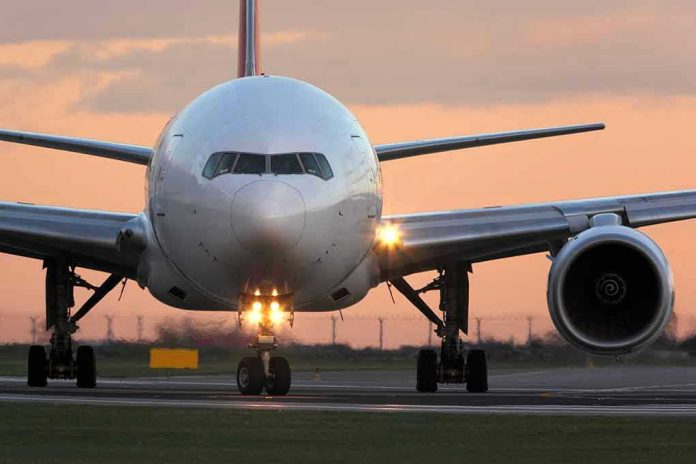
A lithium battery exploded into flames aboard an Air China flight carrying 160 passengers, forcing an emergency landing and exposing the ongoing dangers of inadequate safety enforcement in commercial aviation.
Story Snapshot
- Lithium battery ignited in overhead compartment on Air China flight CA139 from Hangzhou to Incheon on October 18, 2025
- Flight crew extinguished fire and executed emergency landing in Shanghai with no injuries reported
- Incident joins growing pattern of lithium battery fires on aircraft, raising questions about passenger compliance and regulatory enforcement
- Video footage captured flames and passenger panic, underscoring real-time danger posed by portable electronics
Mid-Flight Emergency Forces Diversion
Air China flight CA139 departed Hangzhou for Incheon, South Korea, on October 18, 2025, when a lithium battery stored in a passenger’s carry-on luggage spontaneously combusted in the overhead compartment. The battery burst into flames mid-flight, triggering immediate alarm among the 160 passengers aboard. Flight crew responded swiftly according to established emergency protocols, extinguishing the fire and reassuring panicked travelers. The captain diverted the aircraft to Shanghai, where it executed an emergency landing. Air China confirmed via social media that “the crew immediately handled the situation according to procedures, and no one was injured,” though the incident left passengers shaken and authorities investigating.
Video footage from inside the cabin shows visible flames erupting from the overhead bin as passengers react with shock and concern. The rapid crew response prevented what could have escalated into a catastrophic situation at 30,000 feet. All passengers were safely evacuated upon landing, and Air China reiterated its adherence to international safety standards while launching an internal review. The incident underscores the persistent challenge airlines face in enforcing battery safety regulations, despite clear warnings and restrictions on lithium battery transport in checked luggage.
Pattern of Battery Fires Raises Alarm
This Air China incident is far from isolated. In January 2025, a power bank fire on another flight injured seven people, demonstrating the real human cost of inadequate enforcement. Airlines such as Southwest have implemented stricter policies requiring passengers to keep batteries in plain sight and restricting their use during flights, yet compliance remains inconsistent. The proliferation of personal electronic devices—smartphones, tablets, laptops, power banks—has dramatically increased the frequency of lithium battery incidents on aircraft. Aviation authorities have long recognized the fire risk, establishing regulations that prohibit lithium batteries in checked luggage due to thermal runaway dangers, yet passenger awareness and adherence lag behind safety requirements.
Lithium batteries store tremendous energy in compact form, making them ideal for consumer electronics but also prone to overheating and combustion when damaged, improperly manufactured, or exposed to pressure changes. Thermal runaway occurs when a battery’s internal temperature rises uncontrollably, leading to fire or explosion. Airlines and regulators have updated safety protocols, including mandatory crew training for fire suppression and passenger advisories at check-in and boarding. Despite these measures, enforcement remains inconsistent, particularly among international carriers operating across multiple regulatory jurisdictions. The Air China incident demonstrates that even on major international routes with established safety standards, the threat persists due to passenger behavior and inadequate screening processes.
Regulatory Gaps and Industry Response
Aviation safety experts emphasize the critical importance of rapid crew response and call for stricter enforcement of battery carriage rules. Some experts predict increased restrictions on battery use and carriage, especially for power banks and spare batteries, which pose the highest risk. Regulatory bodies may consider harmonizing international standards for battery transport to close gaps that allow dangerous items to slip through screening. Manufacturers face mounting pressure to improve battery technology and design safer products, including fireproof cases and built-in thermal management systems. The incident places economic costs on airlines for emergency response, investigations, and potential compensation, while also damaging Air China’s reputation among safety-conscious travelers.
The broader airline industry confronts difficult choices between passenger convenience and safety. Outright bans on certain battery types in carry-on luggage would reduce risk but inconvenience millions of travelers who rely on portable electronics. Technological solutions, such as fireproof battery cases or improved detection systems at security checkpoints, offer potential middle ground but require significant investment and coordination across international aviation networks. Researchers highlight the need for better passenger education, as many travelers remain unaware of the dangers posed by damaged or improperly stored batteries. Calls for international cooperation on battery safety standards are increasing, with industry groups advocating for unified policies that eliminate regulatory arbitrage and ensure consistent enforcement worldwide.
Sources:
Lithium battery stored in Air China passenger’s case explodes












